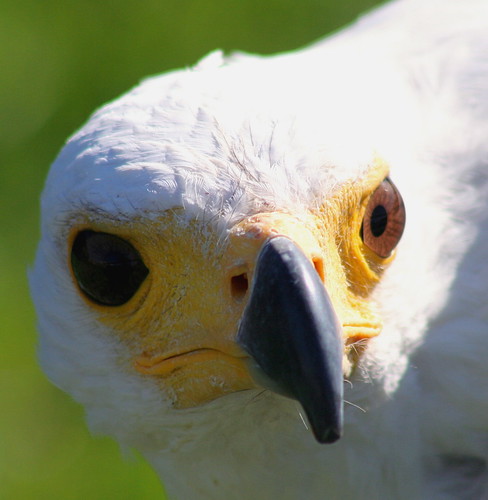In search of the Matese Falcon #15 - African Fish Eagle, Malta Falconry Centre

Image by foxypar4
The African Fish Eagle (Haliaeetus vocifer or â€" to distinguish it from the true fish eagles (Ichthyophaga), the African Sea Eagle â€" is a large species of eagle. It is the national bird of Zimbabwe and Zambia.
Its closest relative appears to be the critically endangered Madagascar Fish-eagle. Like all sea-eagle species pairs, this one consists of a white-headed species (the African Fish Eagle) and a tan-headed one. These are an ancient lineage of sea-eagles, and as such have dark talons, beaks, and eyes. Both species have at least partially white tails even as juveniles.
The African Fish Eagle is a large bird, and the female, at 3.2-3.6 kg (7-8 lbs) is larger than the male, at 2-2.5 kg (4.4-5.5 lbs). Males usually have a wingspan of about 2 m (6 feet), while females have wingspans of 2.4 m (8 feet). The length is 63-75 cm (25-30 in). They are very distinctive in appearance with a mostly brown body and large, powerful, black wings. The head, breast, and tail of African Fish Eagles are snow white and the hook-shaped beak is mostly yellow with a black tip.
This species is still quite common near freshwater lakes, reservoirs, or rivers, although they can sometimes be found near the coast at the mouths of rivers or lagoons. As their name implies, African Fish Eagles are indigenous to Africa, ranging over most of continental Africa south of the southern-most edge of the Sahara Desert.
Breeding season for African Fish Eagles is during the dry season, when water levels are low. African Fish Eagles are believed to mate for life, and pairs will often maintain two or more nests, which they will frequently re-use. Because nests are re-used and built upon over the years the nests can grow to be quite large, some reaching 2m (six feet) across and 1.2 m (4 feet) deep. The nests are placed in a large tree and built mostly of sticks and other pieces of wood.
The female lays 1 to 3 eggs, which are primarily white with a few reddish speckles. Incubation is mostly done by the female, but the male will incubate when the female leaves to hunt. Incubation lasts for 42 to 45 days before the chicks hatch. The eggs will often hatch a few days apart, and the eldest chick will usually kill any younger chicks. Fledging lasts for 70 to 75 days, and after about 8 weeks the chick is capable of feeding itself and will usually begin to venture outside of the nest 2 weeks later.
The African Fish Eagle feeds mainly on fish, which, upon spying it from a perch in a tree, it will swoop down upon and snatch from the water with its large clawed talons and fly back to its perch to eat. Should the African Fish Eagles catch a fish over 1.8 kg (4 pounds) it will be too heavy to allow it to get lift, so it will instead drag the fish across the surface of the water until it reaches the shore. If it catches a fish that is too heavy to even allow the eagle to sustain flight, it will drop into the water and paddle to the nearest shore with its wings. It will also feed on waterfowl, small turtles, baby crocodiles, and carrion.
From Wikipedia
No comments:
Post a Comment